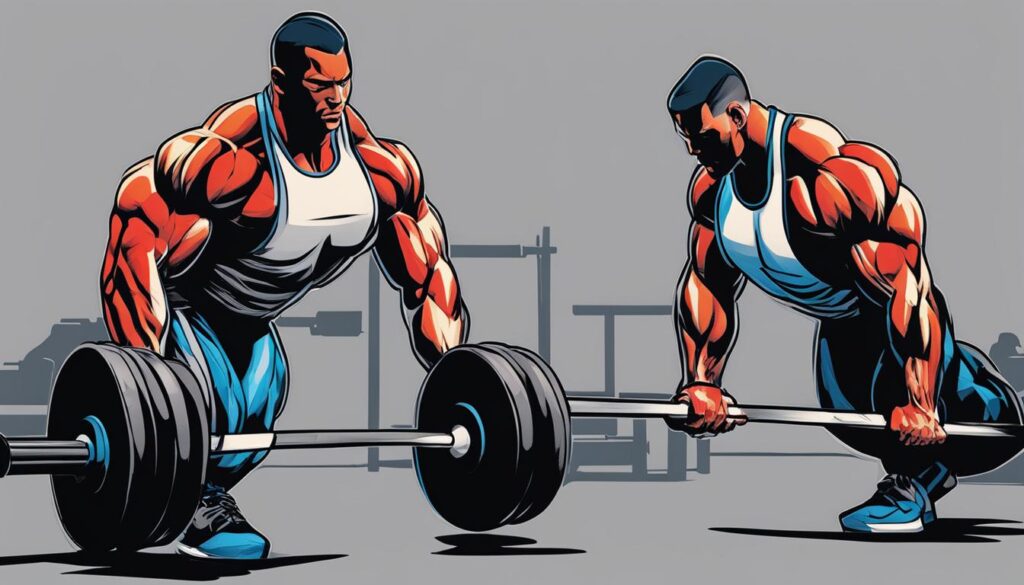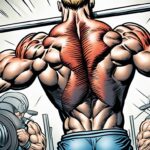The Art of muscles worked in deadlift
Did you know that the deadlift is considered one of the most effective exercises for building overall strength and power? It engages multiple muscle groups simultaneously, making it a go-to choice for many fitness enthusiasts and athletes. Whether you’re a beginner or a seasoned lifter, understanding the specific muscles worked in a deadlift can help you optimize your training routine and achieve your fitness goals.
In this article, we will delve into the primary and secondary muscles activated during a deadlift, the importance of grip strength, and the benefits of incorporating deadlifts into your strength training routine. By the end, you’ll have a comprehensive understanding of how deadlifts can contribute to your muscle development and overall fitness.
Key Takeaways:
- The deadlift is a powerful exercise that targets multiple muscle groups.
- The primary muscles worked in a deadlift include the glutes, hamstrings, and erector spinae.
- Secondary muscles, such as the quadriceps, core, and upper body, also play a role in the movement.
- Grip strength is essential for a successful deadlift and can be improved through specific training.
- Incorporating deadlifts into your routine can help build overall strength and power.
The Primary Muscles Engaged in Deadlifts
When it comes to deadlifts, understanding the primary muscles worked is essential for maximizing your workout and achieving optimal results. This compound exercise primarily targets the muscles in your posterior chain, which includes the muscles in the back of your body.
The main muscles engaged during a deadlift are:
- Glutes: The gluteal muscles, including the gluteus maximus, medius, and minimus, are the powerhouse of the lower body. They are responsible for hip extension, which is a crucial movement in deadlifts, helping you generate power and explosiveness.
- Hamstrings: The hamstring muscles consist of the biceps femoris, semitendinosus, and semimembranosus. These muscles play a significant role in hip extension, as well as knee flexion, allowing for the proper execution of the deadlift movement.
- Erector Spinae: The erector spinae muscles, located along the spine, are responsible for maintaining an upright posture and spinal extension during the deadlift. They provide stability and help prevent lower back injuries.
By targeting these primary muscles, deadlifts effectively engage your lower body, helping you build strength, power, and stability. The posterior chain activation during the exercise contributes to improved athletic performance and overall functional strength.
Deadlifts primarily target the muscles in your posterior chain, including the glutes, hamstrings, and erector spinae. These muscles play a crucial role in generating power and maintaining stability throughout the movement.
Primary Muscles Worked in Deadlifts
| Muscle Group | Specific Muscles |
|---|---|
| Glutes | Gluteus maximus, medius, and minimus |
| Hamstrings | Biceps femoris, semitendinosus, and semimembranosus |
| Erector Spinae | Spinalis thoracis, longissimus thoracis, iliocostalis lumborum, and others |
Secondary Muscles Activated in a Deadlift
While the primary focus of deadlifts is on the posterior chain, several secondary muscles are also engaged during the exercise. Understanding how these muscles work can help you maximize the benefits of your deadlift routine.
The Quadriceps
One of the secondary muscles worked in a deadlift is the quadriceps, which are located on the front of your thighs. As you extend your knees during the lift, the quadriceps play a significant role in helping you achieve full hip and knee extension.
The Core Muscles
Your core muscles, including the abdominals and obliques, are heavily involved in deadlifts. They play a crucial role in maintaining stability and preventing injury. By engaging your core, you create a strong base of support and protect your spine throughout the movement.
The Upper Body Muscles
While deadlifts primarily target the lower body, the upper body muscles also come into play. The lats, located on the sides of your back, help stabilize your spine and maintain proper form. Your traps, which run along your neck and upper back, are responsible for initiating the upward movement of the barbell.
Proper grip and control are essential during deadlifts, and your upper body muscles contribute to maintaining a secure grip on the barbell.
| Secondary Muscles | Functions |
|---|---|
| Quadriceps | Assist in achieving full hip and knee extension |
| Core Muscles | Maintain stability and protect the spine |
| Upper Body Muscles (lats, traps) | Stabilize the spine, maintain grip, and initiate barbell movement |
Engaging these secondary muscles during deadlifts not only enhances your overall strength but also improves your performance in other exercises and daily activities. Incorporating deadlifts into your fitness routine can help you develop a well-rounded physique and improve functional strength.

The Importance of Grip Strength in Deadlifts
Strong grip strength is essential for a successful deadlift. When performing this compound exercise, your grip is often the limiting factor in how much weight you can lift. The muscles worked in your forearms, specifically the flexor digitorum profundus and flexor pollicis longus, play a crucial role in maintaining a secure grip on the barbell.
To prevent slipping or dropping the weight prematurely, it is important to train and improve your grip strength. Incorporating specific grip training exercises into your routine can help strengthen the muscles in your forearms and improve your ability to hold onto heavy loads during deadlifts.
Forearm Grip Training Exercises
Here are some effective forearm grip training exercises that you can incorporate into your workout routine:
- Farmer’s Walk: This exercise involves holding a pair of heavy dumbbells or kettlebells in each hand and walking for a specified distance. It effectively targets your grip and forearm muscles.
- Plate Pinch: Place two weight plates together, smooth sides facing outwards, and pinch them between your fingers and thumb. Lift the plates off the ground and hold for a certain amount of time.
- Dead Hang: Hang from a pull-up bar or sturdy ledge with your arms fully extended. This exercise not only strengthens your grip but also engages your entire upper body.
By consistently incorporating these grip training exercises into your routine, you can improve your grip strength, enhance your deadlift performance, and reduce the risk of grip fatigue or failure during heavy lifts.
Muscles Worked in a Deadlift
| Primary Muscles | Secondary Muscles |
|---|---|
| Glutes | Quadriceps |
| Hamstrings | Core (abdominals, obliques) |
| Erector Spinae | Upper body (lats, traps) |
| Forearms (flexor digitorum profundus, flexor pollicis longus) |
The table above highlights the primary and secondary muscles worked in a deadlift. While the primary focus is on the glutes, hamstrings, and erector spinae, the exercise also engages the quadriceps, core muscles, upper body, and forearms, all of which contribute to maintaining proper form and executing a successful deadlift.
The Thrust of Power: Deadlifts for Building Strength
Deadlifts are a compound exercise that recruits multiple muscles simultaneously, making them an effective method for building overall strength. By engaging key muscle groups, deadlifts promote muscle growth and increase strength and power, both in the lower body and upper body. Incorporating deadlifts into your strength training routine can provide a well-rounded workout and contribute to overall muscular development.
When performing deadlifts, the primary muscles worked include the glutes, hamstrings, and erector spinae, which are responsible for generating power and maintaining stability throughout the movement. However, deadlifts also engage secondary muscles such as the quadriceps, core muscles, and upper body muscles, including the lats and traps.
Before we delve into the benefits of deadlifts for building strength, let’s take a closer look at the muscle recruitment that occurs during this compound exercise.
The Muscles Worked in Deadlifts:
| Primary Muscles | Secondary Muscles |
|---|---|
| Glutes | Quadriceps |
| Hamstrings | Core Muscles (Abdominals and Obliques) |
| Erector Spinae | Upper Body Muscles (Lats and Traps) |
Table: Muscles Worked in Deadlifts
As shown in the table above, deadlifts primarily target the lower body muscles, including the glutes, hamstrings, and quadriceps. These muscles work together to extend the hips and knees, generating power and allowing you to lift heavy weights. By continuously challenging these muscles, deadlifts contribute to muscle growth and overall strength.
Additionally, deadlifts engage the core muscles, which play a crucial role in maintaining stability throughout the movement. A strong and stable core not only supports your spine during the lift but also enhances your overall performance in various exercises and daily activities.
Furthermore, deadlifts activate the upper body muscles, particularly the lats and traps. These muscles come into play as you maintain a proper grip on the barbell and control the weight during the lift. Strengthening these muscles can improve your grip strength and prevent any slippage or premature weight release.
By targeting both the lower and upper body muscles, deadlifts provide a comprehensive strength training workout. The compound nature of this exercise stimulates muscle growth and enhances overall strength and power.
Conclusion
Understanding the muscles worked in a deadlift is crucial for optimizing your training routine and achieving your fitness goals. By targeting the primary muscles in the posterior chain, engaging the secondary muscles, and emphasizing grip strength, deadlifts allow you to build strength and power throughout your entire body.
Deadlifts are a compound exercise that recruits multiple muscle groups simultaneously, making them an effective tool for building overall strength. By incorporating deadlifts into your exercise regimen, you can experience the benefits of this compound movement on your muscle development and overall fitness.
Whether you are looking to increase your strength, build muscle, or improve athletic performance, deadlifts are a versatile and effective exercise that can be tailored to your individual needs. By consistently incorporating deadlifts into your routine, you can target key muscle groups, enhance your overall strength and power, and see remarkable results.
FAQ
What are the key muscles worked in a deadlift?
The key muscles worked in a deadlift are the glutes, hamstrings, and erector spinae. These muscles in the posterior chain play a crucial role in generating power and maintaining stability during the movement.
Are there any secondary muscles engaged during a deadlift?
Yes, there are secondary muscles engaged during a deadlift. The quadriceps, which are located on the front of your thighs, are activated as you extend your knees. Additionally, your core muscles, including the abdominals and obliques, are engaged to maintain stability. The upper body muscles, such as the lats and traps, also come into play as you maintain proper grip and control.
How important is grip strength in a deadlift?
Grip strength is crucial in a deadlift. The muscles worked in your forearms, including the flexor digitorum profundus and flexor pollicis longus, play a significant role in maintaining a secure grip on the barbell. Improving your grip strength can enhance your deadlift performance and prevent slipping or dropping the weight prematurely.
Can deadlifts help in building overall strength?
Yes, deadlifts are an effective method for building overall strength. They are a compound exercise that recruits multiple muscles simultaneously. By engaging key muscle groups, deadlifts promote muscle growth and increase overall strength and power in the lower body and upper body.
How can understanding the muscles worked in a deadlift optimize my training routine?
By understanding the muscles worked in a deadlift, you can target specific areas and enhance your overall performance. By targeting the primary muscles in the posterior chain, engaging the secondary muscles, and emphasizing grip strength, you can optimize your deadlifts to build strength and power throughout your entire body.
